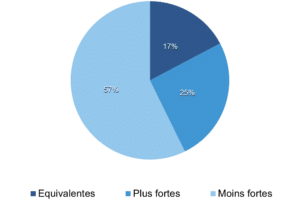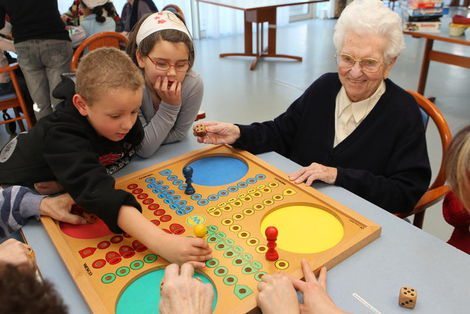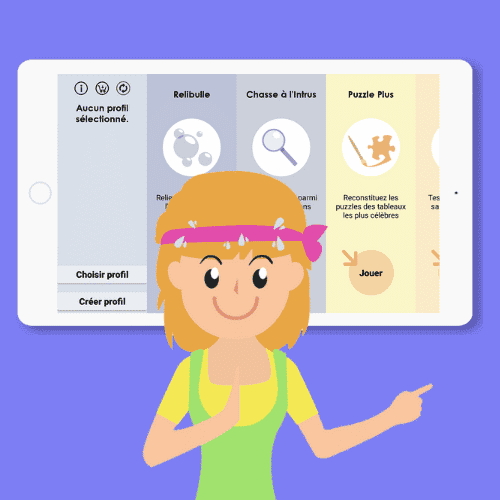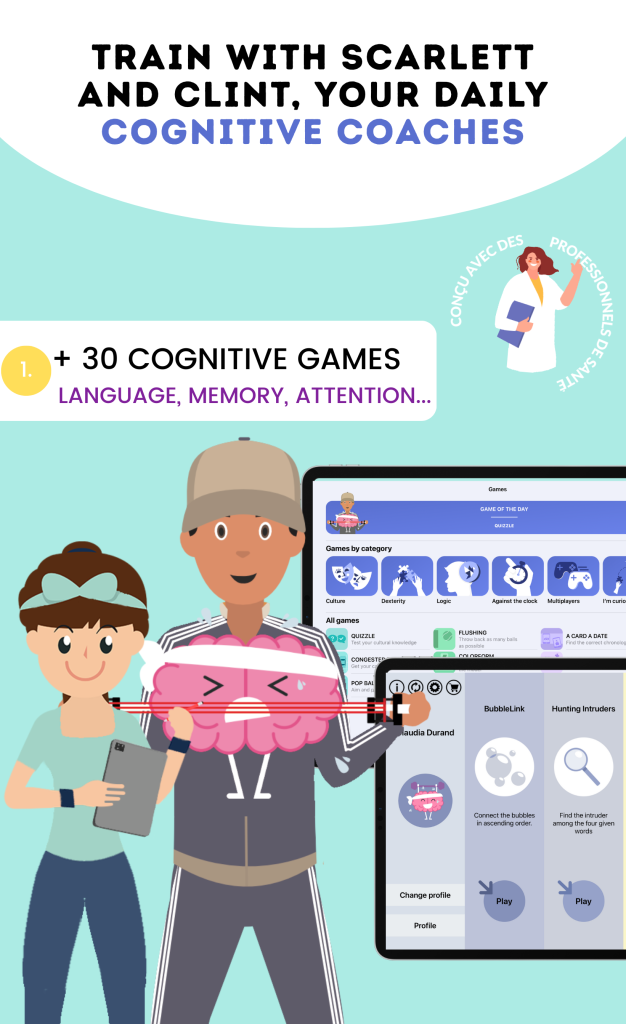Results of the survey on intergenerational activities in nursing homes: Tips and best practices
Dynseo publishes its survey on the most effective activities to improve intergenerational links for seniors in nursing homes.
The aim of this survey is to provide an overview of intergenerational activities as well as the state of intergenerational relationships in France, and then to benefit nursing homes looking for new ideas.

Starting from the observation that intergenerational exchanges are not always easy to implement in nursing homes, Dynseo has transcribed several studies as well as various activities practiced in care homes.
Connecting a child and a senior can prove to be a complex task; they do not share the same codes, references, and often have little patience!
Nevertheless, intergenerational meetings remain important in nursing homes; children, always full of life, bring many smiles; the elderly will be delighted to share memories, know-how, passions, habits, and customs that younger generations no longer perpetuate.
What does intergenerational mean to you?
The five most cited words are as follows:
- exchanges
- help
- links
- young
- elderly people
Do you think that today, the relationships between generations are stronger, equivalent, or weaker than they were 20 years ago?

- 82% of respondents say they currently participate in an intergenerational solidarity activity.
- Among those under 25, the participation rate in these activities is 68%, while among those aged 65 and over, it is 92%.
List of intergenerational activities regularly practiced in nursing homes:
- Singing
- Visual arts
- Body expression
- Dance workshops
- Mimes and gesture games
- Activities for certain holidays, such as decorating Easter eggs.
- Activity exchanges, for example, high school students coming to teach seniors about computers while they learn sewing.
- Games for seniors on tablets
- Story reading
- Board games

Feedback on intergenerational workshops
Interview with Bernard BRENOT, director of the Marpas of Franche Comté

What is a Marpa?
A Marpa is a welcoming home and residence for autonomy, a small living unit accommodating a maximum of 24 autonomous residents aged 60 and over. These structures are non-medicalized and consist of single-storey apartments. Residents are tenants and live as if at home but can benefit from collective services (such as dining).
What does intergenerational mean to you in a senior care home? Do you find it useful?
It is about maintaining connections with the outside: a stimulation for some and a discovery for others. The younger ones lead their elders out of their routine, while the older ones share their experiences and knowledge. It is a source of mutual enrichment.
Do you often practice intergenerational activities in your MARPA in Franche Comté? What are they?
We organize them as often as possible, without disturbing residents who tire quickly. We hold meals with school children regularly, artistic expression workshops… school performances or projects around Stim’art…
Recently, some MARPA in Franche Comté participated in an experiment: having seniors play the Dynseo game app on tablets, can you tell us about it?
The hardest part was getting residents to accept playing and “putting themselves at risk” in front of a program, but also to “take possession” of the tablet itself and its technology… The period of mutual domestication was relatively long and took a lot of time considering the duration of the experiment, but what a success when residents took ownership of the programs!
Is it a success in your MARPA?
Yes! The proof is that some teams would like to try the tablet games experience again, but by integrating it into broader projects to create links and strengthen existing ones. Thus, particularly with the establishment in Pierrefontaine-les-Varans, we are working on a large intergenerational project, with tablets, but also many other intergenerational exchanges.
Is it a success in terms of intergenerational links?
Yes, but we need to deepen this aspect based on exchange and reciprocity, to learn to know each other better, and thus promote respect.

Another testimony
Do you also have an experience of an intergenerational workshop that you would like to share with us? Write to us at contact@dynseo.com and we will enrich this intergenerational file with your testimonies!
A complete brain training with the SCARLETT application
SCARLETT is an application designed for people with cognitive disorders. Through more than 30 games, the player works on all of their cognitive functions while having fun. Take advantage of the trial week to test the SCARLETT application for free right now!

The impact of intergenerational activities on the mental health of seniors
Intergenerational activities play a crucial role in the mental well-being of elderly people. By promoting social interactions, these activities help reduce isolation and improve the quality of life for seniors. Here are some observed benefits:
- Reduction of stress: Exchanges with younger generations bring lightness and joy, thus decreasing stress and anxiety.
- Cognitive stimulation: Participating in varied activities stimulates cognitive functions, thus preventing mental decline.
- Boosting self-esteem: Seniors feel valued when they share their experiences and skills with younger people.
- Creation of social bonds: These activities allow for the weaving of new connections, thus reducing feelings of loneliness.
How to organize effective intergenerational activities in nursing homes
To maximize the impact of intergenerational activities, it is essential to organize them well. Here are some key steps to follow:
- Assessment of needs: Identify the interests and abilities of residents as well as young participants.
- Creation of a calendar: Establish a regular activity schedule to maintain participant engagement.
- Collaboration with schools: Work in partnership with educational institutions to facilitate exchanges.
- Training of staff: Raise awareness and train staff on the issues of intergenerational activities for better implementation.
- Feedback: Gather feedback from participants to adjust and improve the proposed activities.
Examples of innovative intergenerational activities
Here are some ideas for intergenerational activities that have proven successful in various nursing homes:
- Culinary workshops: Preparing traditional recipes together, allowing seniors to pass on their culinary know-how.
- Artistic projects: Creating collective works of art, such as murals or sculptures, that can be displayed in the nursing home.
- Sports days: Organizing adapted sports events, promoting cooperation between generations.
- Reading clubs: Discussing books or films, allowing seniors to share their memories and young people to discover classic works.
Challenges to overcome to promote intergenerational activities in nursing homes
Although intergenerational activities are beneficial, several challenges must be overcome:
- Cultural differences: Cultural and reference gaps can hinder exchanges; it is important to find common ground.
- Lack of resources: Nursing homes may lack financial or human resources to organize these activities.
- Resistance to change: Some residents may be reluctant to participate in activities with young people, requiring a gentle and gradual approach.
- Logistics: Ensuring an appropriate and accessible space for all participants is essential for the success of the activities.





